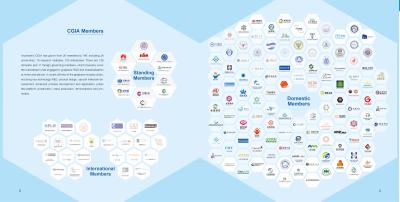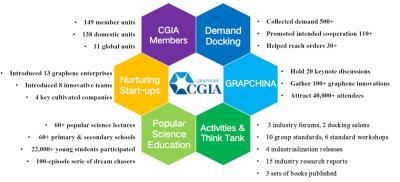The Chinese Graphene Industry Association (CGIA) was established in 2013, to help promote the graphene industry in China, and has grown to over 150 members today. Recently we talked with Minyang Lu, Deputy Secretary-General of the CGIA. Major in charge of international cooperation, some domestic projects cooperation and organizing of the GRAPCHINA conference.
Q: Hello Minyang. The CGIA has grown to be the leading graphene trade organization in China, with over 150 members. Can you describe the CGIA's main activities and work?
China Innovation Alliance of the Graphene Industry – CGIA - was established on 13th of July 2013 in Beijing. It is a consortium of industrialized enterprises, academic institutions, and research organizations that are devoted to the research and development of graphene and graphene based products. The CGIA was established in order fulfill the needs of its members and their common interests, improve industrial technology innovation, and assist with legal contracts.
The tasks include:
- Advocating for the cooperation among research institutes, universities, manufacturers, and investors
- Building dialogue between scientists, entrepreneurs and government officers
- Coordinating business development of graphene industries
- promoting technology innovation
- Building international cooperation
- Setting up a universal standard and evaluation system
- Protecting intellectual property
Q: As graphene is moving from R&D to commercialization, how do you see the CGIA's role in China's graphene industry and market?
As an emerging material, graphene plays a huge role in upgrading traditional industries and cultivating emerging industries. China has the largest market in the world, which undoubtedly provides a valuable ground for the development of graphene R&D projects.
At the basis of its operation, the CGIA aims to integrate and coordinate industrial resources, build a global graphene industry service platform, and promote the healthy development of the graphene industry. We have created a specific method of promoting the Chinese graphene industry. First, we have established a graphene project database, which contains various graphene R&D projects, which will be divided into different stages like: “laboratory results”, “pilot stage” and “commercialization results” according to project maturity. Different cultivation methods are adopted for different stages of the project.
For projects in the “laboratory results” stage, we will keep tracking the projects, or we may co-fund an institute to incubate this project; for “pilot stage” projects, we will help find investments; for “commercialization stage” projects, we will organize some activities like innovation competitions to attract investors, downstream companies, decision makers from the companies etc. At this competition, a kind of roadshow, we will provide the project owner with an opportunity to introduce itself to the public, and invite several experts from tech R&D, business management and finance aspects to evaluate if this project is suitable for the local industry. If it is, the government will provide industrial policy supports to further develop the project in their industrial zones.
Secondly, we cooperate with local governments with good industrial bases to introduce the projects in our project library by holding innovation competitions or project promotion activities. Then, we develop a graphene industrial plan and combine the needs of local industry to build an industrial demonstration base. An industrial demonstration base is something like an industrial cluster - a Chinese practice that may be less common in other places. But generally, it’s an industrial park or zone which is co-funded by government, CGIA, graphene companies and investors. Several graphene related companies will have their factory or HQ at this Base. This base will contain several different graphene companies in one industrial park, which is much easier to manage and also easier for the government to support. It also saves costs and improves work efficiency.
Finally, CGIA will provide capital, technology and market services for the graphene projects which are brought into the local cluster. Through this method, we have introduced nearly one hundred graphene projects to more than 20 cities in China.
Furthermore, CGIA provides more accurate market reach services by helping graphene companies to explore their market. We provide market promotion, finding investors, raising funds and so on. The example I listed below, the Sinopec, could be a good example. Lots of graphene based coating or lubricant companies mentioned their products are struggling to enter the market, despite the fact that graphene based coatings have better properties, because these markets are already occupied by traditional coating enterprises. Customers are not even aware of graphene coatings. So we cooperate with Sinopec(EPEC) to jointly create a “Graphene Category”, from where Sinopec and other customers could purchase graphene based coating via this platform. For now, Sinopec is planning to buy graphene coatings from this platform, EPEC. We have 5 CGIA members that have already signed agreements or contracts with Sinopec to place their products on EPEC. Right now, they are working with Sinopec and CGIA on products certification and trial experiments for those cultivated projects and enterprises. The CGIA has successfully built cooperations with large-scale enterprises or industry organizations such as Sinopec, hospitals, and equipment companies, to fully expand the market.
Q: Where do you see graphene making the most impact today in China?
Graphene has played an important role in China mainly in some different areas of people's lives, the transformation and upgrading of traditional industries, and some major national engineering projects. For example, graphene thermal materials have been applied in mobile phone brands such as Huawei and Xiaomi. The recently released HUAWEI Pocket S smartphone by Huawei features a "super-cool flexible graphene thermal system" that increases heat dissipation area by 62% and thermal conductivity area by 80%. Graphene conductive slurry is used in electric vehicle batteries in China, significantly improving the charging and discharging speed of the batteries. Graphene anti-corrosion coatings have been applied in some bridges, high-speed railways, and transmission towers, with salt spray resistance far exceeding that of ordinary zinc powder anti-corrosion coatings.
Graphene water purification technology has been applied in some cities in China, significantly improving the quality of rivers and other bodies of water. Graphene energy-saving heating technology has been applied in many cities in northern area, achieving the goal of reducing carbon emissions by using clean energy to provide heating for houses. Graphene functional fibers have antibacterial, anti-static, and insulation effects, and have been widely used in the 2022 Winter Olympics. There are many similar cases, and graphene technology is entering the lives of ordinary people in China.
Q: Where do you see China's main advantages in the global graphene market? How does the CGIA help graphene companies in China address global markets?
Firstly, China has leading graphene scale-up production capabilities. Many graphene production companies can produce 100 tons per year, and some even reach a thousand tons per year. With the continuous scale-up of production technologies, graphene quality and cost are more easily accepted by market customers. Secondly, China has a large group of technical personnel, providing a continuous source of growth for graphene technology innovation. Thirdly, China has the world's largest application market, which can provide good market support for various graphene application technologies. For example, graphene thermal technology has become one of the necessary heat dissipation solutions for Chinese smartphone manufacturers.
Just like the declaration made by CGIA and its global partners at the GRAPCHINA conference, we firmly believe that we are a community with a shared future and that the graphene industry should maintain international exchange and cooperation. CGIA itself has established good trust and communication mechanisms with many overseas graphene institutions and companies. We provide smooth channels for Chinese graphene companies to go global by building diverse exchange platforms with these overseas institutions. At the same time, CGIA will also host a global graphene conference in China every year - GRAPCHINA.
We will invite global graphene experts, institutions, and companies to visit Chinese graphene companies and the Chinese market. We believe that the ancient Chinese saying "seeing is believing" is very important. In order to let more people understand the real situation in China, we invite people to come to China every year and experience China's enthusiasm for global partners firsthand. Through this approach, we hope that global partners can have a deeper understanding of China's efforts and achievements in recent years in building a better intellectual property system and protecting foreign businesses. We believe that through this deeper understanding, global partners will be more willing to cooperate with Chinese graphene companies.
Q: We know that the CGIA is looking to help global companies to establish a presence in China. Can you detail these activities? What do you offer to graphene related companies?
As an industry service organization, CGIA hopes to not only serve the local graphene industry in China but also act as a bridge to help global enterprises connect with the Chinese market. If companies or teams want to create or grow their presence in the Chinese market, we can coordinate our resources to help connect them with venues, policies, and capital. If downstream enterprises are looking for graphene products or application technologies in the Chinese market, we can help with recommendations and connections. We will also release the demands of downstream application enterprises in China and look for suitable partners worldwide to jointly promote the application of graphene technology and upgrade related products.
In fact, there are some cases already progressing under our promotion. One of them is based on the enterprise demand we released to the outside, which attracted a European technology team. With our coordination, the technology team spent 2-3 years refining the technology according to the enterprise's demand. Currently, they are undergoing A-round financing and planning to expand production by building a factory. This year, the product is planned to enter the terminal market for sales through the downstream enterprise.
Q: How do you see the future of graphene in 5 years? Will it finally fulfill its promise?
As a new material system, graphene has developed quite fast, in less than 20 years since its discovery, compared to other materials. We are pleased to see that graphene has gradually penetrated industrial applications and daily life. At the same time, we also notice that many application technologies are still in the trial phase and will gradually enter the market in the next few years, further expanding the application scope of graphene. Of course, not all technologies will be accepted by the market after they mature. They will have to face many challenges in commercialization. However, with the continuous development of technology and the advancement of manufacturing technology, we believe that more graphene technologies will enter the market in different forms and improve our lives in the next few years.
If we hope to achieve a breakthrough in "Moore's Law" through graphene or GRM, this requires more in-depth research and exploration. Although graphene has excellent electrical properties, its application in integrated circuits still faces many technical and engineering challenges, such as preparation, integration, stability, and other issues. Therefore, research in this area requires longer-term efforts and exploration.
The CGIA is calling out to global graphene companies to collaborate on graphene projects in China, in areas of manufacturing, processing, R&D and marketing. You can reach Minyang via email or Phone/WeChat: 0086-1865-7108128


